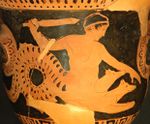Scylla (sea monster)
In Greek mythology, Scylla was a female sea monster mentioned in many of the important surviving ancient Greek and Latin writings that involve sea voyages. Her description is not always consistent across works. In several, she is a six-headed horror with legs made of snakes, who attacked and devoured sailors along one side of a narrow sea passage. In other sources, Scylla is a dangerous rock that ships ran aground on. The narrow passage where the rock was situated even more dangerous because of another nearby sea monster, Charybdis (a whirlpool). Boats in the constricted area could avoid either monster but not both, and the only way to avoid danger was to take a long detour by water. From this came the saying "to be between Scylla and Charybdis", which implies that one can avoid immediate danger only by making an unwanted, long detour through uncharted waters. The saying corresponds (though not perfectly) to the English figure of speech "to be between a rock and a hard place".
While Scylla is mentioned throughout ancient literature mainly as a hazard to be avoided, Ovid gave her a gripping origin story in his book Metamorphoses, and it is both Scylla's teamwork with Charybdis and her transformation from a young and beautiful woman into a monster that make her worth story so compelling.
